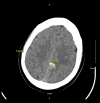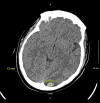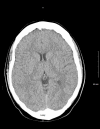A Rare Case of Idiopathic Reversible Cerebral Vasoconstriction Syndrome
- PMID: 39305005
- PMCID: PMC11421186
- DOI: 10.12659/AJCR.944273
A Rare Case of Idiopathic Reversible Cerebral Vasoconstriction Syndrome
Abstract
BACKGROUND Reversible cerebral vasoconstriction syndrome (RCVS) is a rare disease that is classified as a condition of diffuse cerebral artery constriction. RCVS can be complicated with transient neurological deficits, seizures, ischemic strokes, and hemorrhagic strokes. A thunder-clap headache, described as being the worst headache a patient can experience, is the predominant symptom in RCVS, which contributes to why RCVS is underdiagnosed as an ischemic stroke or migraine. CASE REPORT In this case study, we present a healthy 34-year-old Black woman who presented to the Emergency Department 3 times over a period of 4 days with concerns of severe headaches. In her first Emergency Department visit, she had a normal computed tomography scan of the brain. Her third Emergency Department visit resulted in hospitalization due to seizures, and a computed tomography brain scan done then showed acute intracranial hemorrhaging. The patient ultimately received a diagnosis of RCVS during her hospitalization. CONCLUSIONS RCVS is the most notable mimicker of other similar-presenting vasculopathies, such as primary angiitis of the central nervous system and posterior reversible encephalopathy syndrome. It is important to note that thunder-clap headache, as well as complications such as intracranial hemorrhaging and seizures, can arise not just from other diseases but from RCVS as well; hence, an early diagnosis is critical to avoid complications, especially if initial imaging is negative.
Conflict of interest statement
Figures






Similar articles
-
Reversible Cerebral Vasoconstriction Syndrome.J Emerg Med. 2015 Jul;49(1):26-31. doi: 10.1016/j.jemermed.2015.01.012. Epub 2015 Apr 7. J Emerg Med. 2015. PMID: 25858343
-
Reversible cerebral vasoconstriction with thunderclap headache: A case report.Medicine (Baltimore). 2019 Dec;98(49):e18254. doi: 10.1097/MD.0000000000018254. Medicine (Baltimore). 2019. PMID: 31804357 Free PMC article.
-
Reversible cerebral vasoconstriction syndrome (RCVS): an interesting case report.J Headache Pain. 2021 Apr 6;22(1):20. doi: 10.1186/s10194-021-01225-7. J Headache Pain. 2021. PMID: 33823785 Free PMC article.
-
[Reversible cerebral vasoconstriction syndrome : A rare cause of stroke].Nervenarzt. 2024 Jun;95(6):564-572. doi: 10.1007/s00115-024-01674-w. Epub 2024 Jun 6. Nervenarzt. 2024. PMID: 38842549 Free PMC article. Review. German.
-
Narrative Review: Headaches After Reversible Cerebral Vasoconstriction Syndrome.Curr Pain Headache Rep. 2020 Nov 8;24(12):74. doi: 10.1007/s11916-020-00908-1. Curr Pain Headache Rep. 2020. PMID: 33161482 Review.
References
-
- Cho TA, Jones A. CNS vasculopathies: Challenging mimickers of primary angiitis of the central nervous system. Best Pract Res Clin Rheumatol. 2020;34(4):101569. - PubMed
Publication types
MeSH terms
LinkOut - more resources
Full Text Sources
Research Materials

